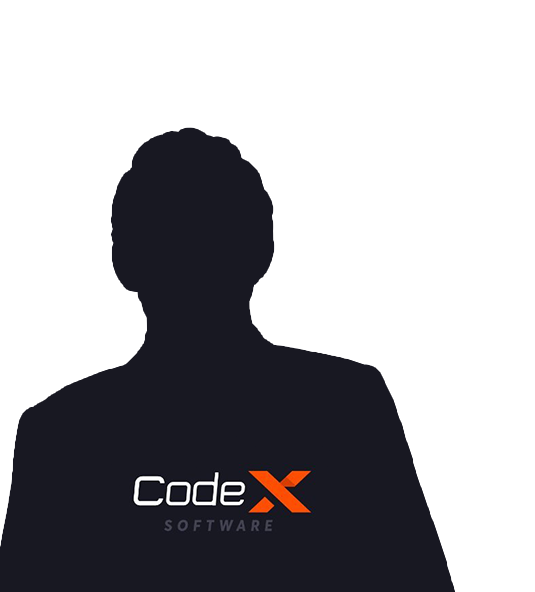Introduction:
The software or technology you choose for your business can either make or break your business because it equally contributes to the business's growth. With the evolving world, every new project might come with some other software requirements. Hence, understanding the difference between open source and proprietary software is important to make a useful choice for business.
Open-source software is typically free, customizable, and community-driven, while proprietary software is developed by companies. But which truly delivers more value in the long run?
This blog will discuss open source vs proprietary software, pros, and cons of open-source and proprietary softwares to help you choose the right fit of software to achieve maximum ROI.
First, let's start with the basics to get more clarity.
What is Open-source Software?
Open source software is a type of software or computer program that is released by a specific business, individuals, or community to make the source code available to the public for free.
As it is open-source, developers and programmers can easily use, edit, and modify the code according to their needs.
Examples of Open-source Software
Below are some examples of open-source software that are used by the majority of big businesses.
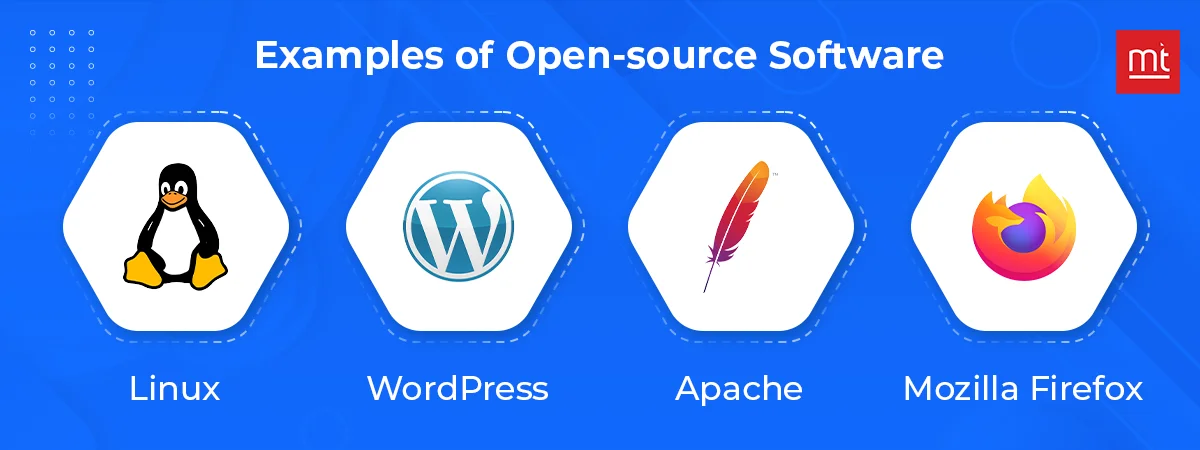
1. Linux
It is a popular open-source operating system recognized for its stability, security, and flexibility. Its importance to modern computing environments is clear since it supports many enterprise servers, cloud infrastructure, and mobile devices, including Android
2. WordPress
It is one of the popular and free content management systems. WordPress drives more than 40% of all sites. It is widely used by companies for blogs, e-commerce, and professional websites because it is user-friendly and provides a variety of themes and plugins for customization.
3. Apache HTTP Server
It is a powerful, open-source web server software that delivers web content across the Internet. It is known for its performance, adaptability, and extensibility. Hence, it's the popular hosting option for websites and applications.
4. Mozilla Firefox
It is a free web browser emphasizing speed, privacy, and user control. This is developed by the Mozilla Foundation and used worldwide for customization, developer tools, and more.
Advantages of Open Source Softwares
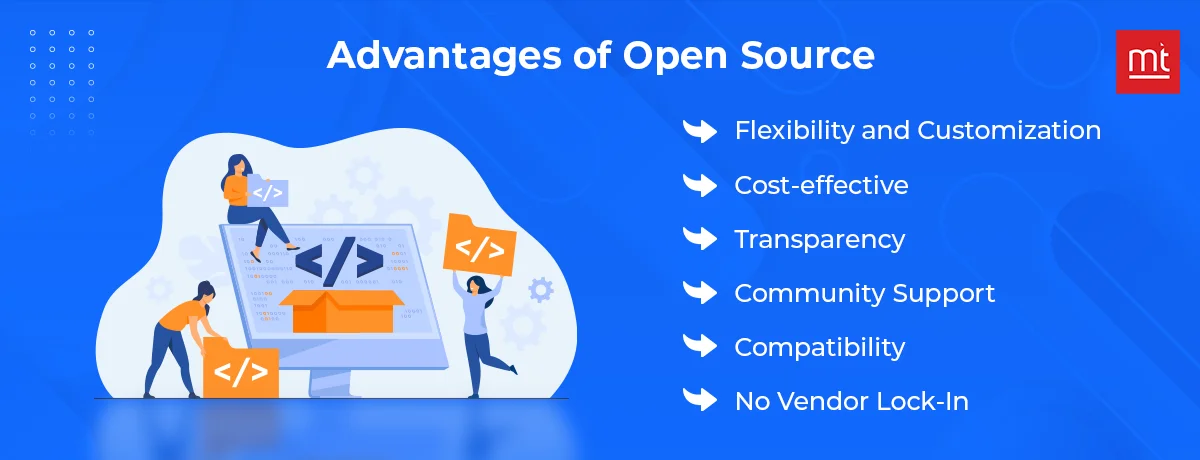
1. Flexibility and Customization
With open source software, you get the freedom to customize and edit the code for your personal use, however you want.
2. Cost-effective
Open-source softwares is the best option to reduce the cost of business on any kind of project because it is freely available and publicly accessible.
3. Transparency
Open source codes are transparent and open to the public, hence it is easy to identify the threats and vulnerabilities. Plus, it's used and trusted by thousands of developers.
4. Community Support
Open-source software has a huge community support, hence you can easily get any kind of support from forums, experts, and online tutorials to fix the bugs.
5. No Vendor Lock-In
The open source software is not in control of any vendor, hence you are not bound to any restrictions. You can use the code as you want without worrying about legal issues.
Disadvantages of Open Source
Though open-source software also has many disadvantages. Here they are.
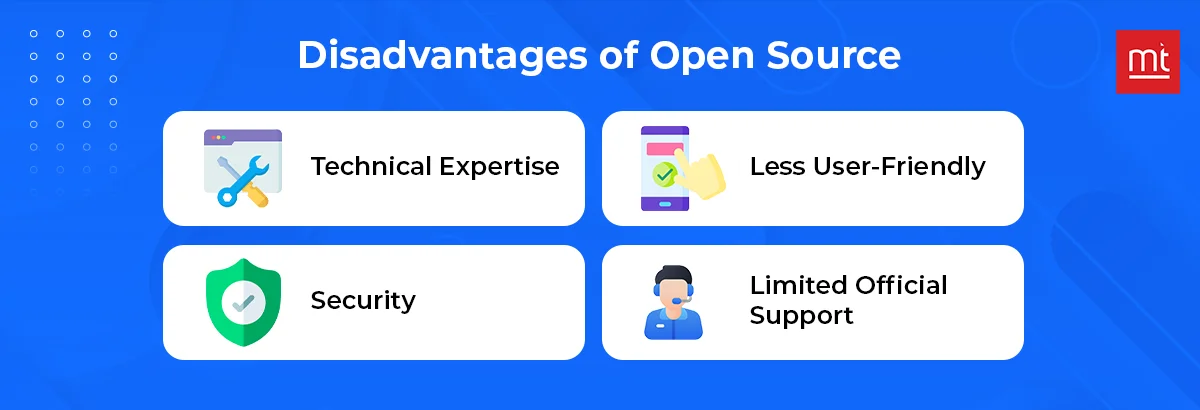
1. Technical Expertise
The free code is already available, but you need technical expertise to edit and configure the code according to requirements. Hence not suitable for a non-tech person.
2. Security
As open source softwares is easily available publicly and transparently, they might be affected by malicious content. It's important to check for regular updates by checking at community support.
3. Less User-Friendly
It focuses more on functionality than user experience. Users unfamiliar with command-line operations or manual configurations may find the software difficult to use.
4. Limited Official Support
There is no actual official vendor support for open source software. You only get support from community forums or volunteer contributors.
Open-Source Business Models
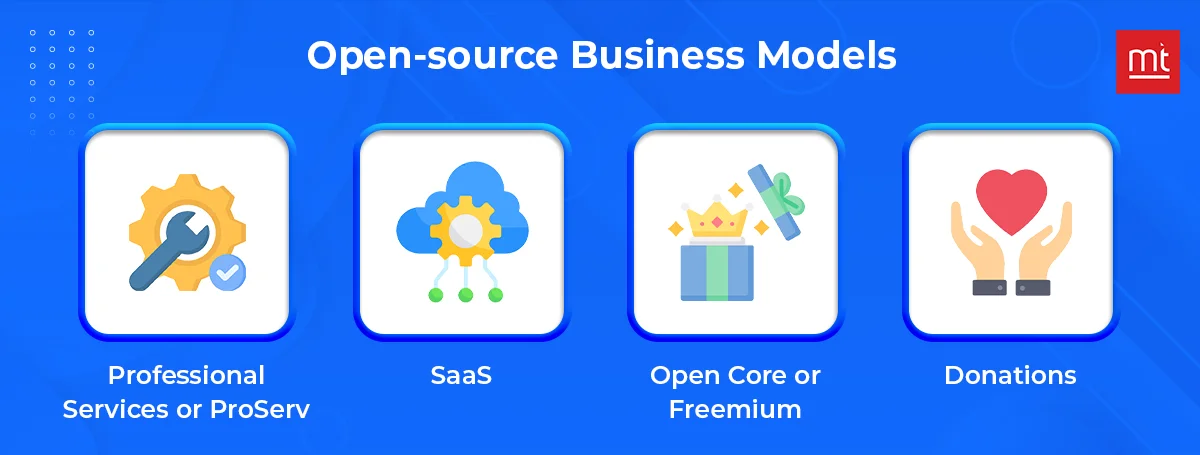
#1. Professional Services or ProServ
Under this approach, companies provide paid services including installation, customization, integration, and open-source software support. Although the fundamental software is free, businesses make money by enabling customers to properly use and control it, usually for enterprises that require professional help and long-term support.
For example: Red Hat, IBM, and more.
#2. Open Core or Freemium
While advanced features, tools, or services are locked behind a paid version, this model offers a free, open-source core version of the software. Popular among businesses aiming for both personal consumers and corporate clients, it promotes adoption via the free tier and monetizes premium features.
Examples are Docker, GitLab, and more.
#3. SaaS
Open-source software is hosted and delivered as a cloud-based service. Users pay for access, hosting, and convenience. while the source code remains open.
For example: WordPress, GitHub, etc.
#4. Donations
Various open-source programs depend on voluntary contributions from independent donors, who are companies or individuals that benefit from the software. This funding approach is most suitable for projects with a strong user community and good faith.
Example: mozilla, wikipedia, etc.
What is Proprietary Software?
Proprietary software can be said to be premium softwares that needs subscriptions and licensing to use it. It is usually protected software where the user needs to pay for it to use and access its code. Plus, it's restricted from the vendor side and does not allow any editing or modification.
You may have heard many names like closed-source, closed-use, commercial software, etc. it means proprietary software is used by a specific developer team or an organization to fulfill their business purpose.
Examples of Proprietary Software
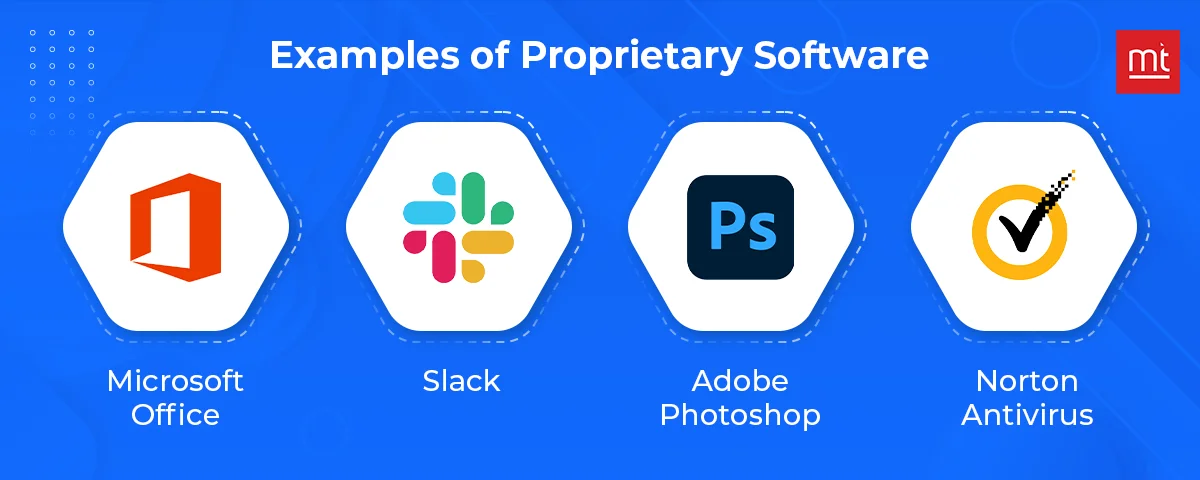
1. Microsoft Office
Microsoft Office is one of the proprietary software programs that comes with paid license versions. It is used in schools, offices, and homes for writing documents, creating spreadsheets, making presentations, and handling routine tasks.
2. Slack
Slack also has free and premium versions. In free versions, users can chat, share files, and organize discussion channels. To access premium features, users can buy the paid version.
3. Adobe Photoshop
Adobe Photoshop is widely used by photographers, designers to edit images. It is paid software, so users need to pay for a subscription to access its advanced functionalities.
4. Norton Antivirus
Norton Antivirus helps to block harmful websites and offers real-time protection by scanning the files in the system. Big organizations and individual users buy their paid version to ensure security.
Advantages of Proprietary Software

1. Professional Support
You get full professional support from the vendor, as you have paid money for their service. They help you with using the tutorial, bug fixing, troubleshooting, and any kind of help whenever required.
2. Security
Proprietary softwares is more highly secured than open-source software as they are not publicly available and only paid users get access to use. Plus, even paid users can't modify or edit the code; the control is in the vendor’s hands.
3. Ease of Use
This softwares comes with guidance and tutorials when you buy them, hence it is easy to use without needing any technical knowledge.
4. Compatibility
Proprietary softwares are compatible. They can be used on various devices, platforms, as well as integrated too.
Disadvantages of Proprietary Software

1. Limited Customization
Features, functionalities, code, and everything is fixed by the vendor, hence, it is what it is. You can't customize it if you have any other needs.
2. Cost
Proprietary softwares is paid and can be expensive. Also, it can add extra money to upgrades and add-ons.
3. Vendor Lock-in
It includes a contract and agreement to licensing conditions, plus you need to depend on the vendor for support and extra functionalities.
4. Privacy Concerns
You might need to share your details like name, age, profession, and bank details to pay for proprietary software, hence it can raise privacy concerns.
Proprietary Software Business Models
Vendors usually sell their paid softwares through these business models.
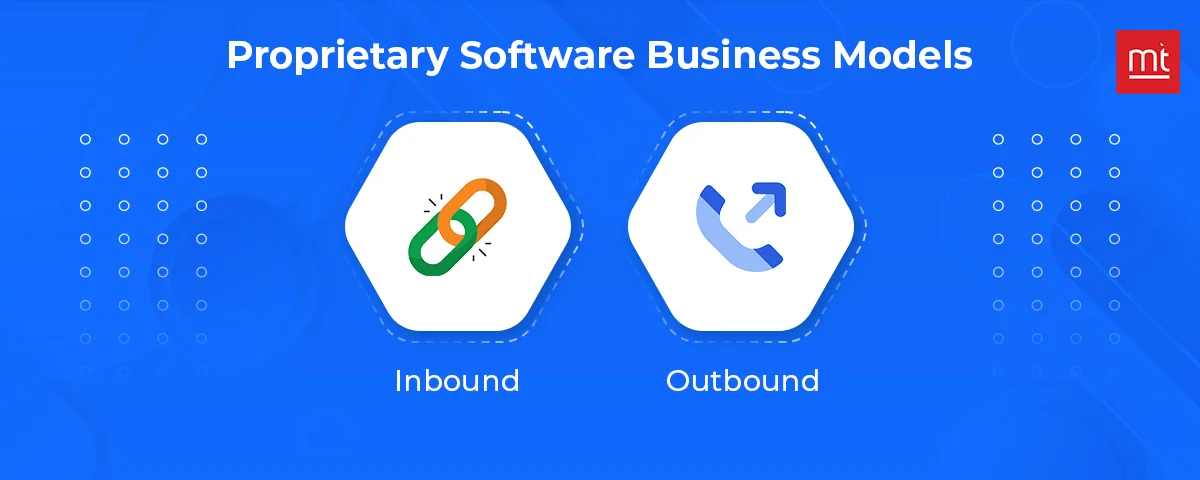
1. Inbound
The majority of vendors use this inbound method to reach a wider audience, which includes using the website to market and promote their product to the audience through SEO, content promotion, social media, podcast, or anything.
2. Outbound
The outbound method means a business pitches about their product to networks and references to close the deal. This basically includes TOFU marketing and is implemented by the business development representative and sales person of the organization.
Open-source Software vs Proprietary Software: Comparison
Aspect | Open Source Software | Proprietary Software |
Cost | They are free of cost. | requires purchasing a license, subscription, or service fees. |
Customization | Highly customizable | Limited customization; adjustments are often restricted by the vendor. |
Source Code Access | Full access to the source code for modification and development. | Source code is closed; modifications are not permitted. |
Community Support | Depends on community-driven support through forums, chats, and online resources. | The vendor provides professional support |
Security | If not maintained, it can be vulnerable because security depends on the community and frequency of updates. | Security teams regularly update the patches and maintain the software |
Ease of Use | This may require more technical expertise to set up and use. | It has a user-friendly interface, so even non-tech users can use it. |
Vendor Lock-In | No vendor lock-in; you can modify and migrate the software as needed. | High vendor lock-in due to proprietary formats and exclusive software features. |
License Control | They don't require a legal license, but might need to fulfill compliance. | They have an authenticated license with restrictions on usage, modification, and distribution. |
Maintenance & Updates | Frequent updates, but may require self-maintenance or third-party services. | It is maintained and updated directly by the vendor. |
Integration | It can be integrated with any third-party tools. Might need custom coding. | It can be easily connected with other vendor products or popular services. |
Development Process | Community-driven development with continuous feedback and collaboration. | Vendor-controlled development, with defined release cycles and planned features. |
Examples | WordPress, Apache, MYSQL, Firefox, etc | Slack, Adobe Flash Player, Photoshop, Norton Antivirus, etc. |
Open-source vs Proprietary Software: The Main Differences
1. Functionality/Features
Open source: It offers unlimited possibilities for technical users to create unique functionalities.
Proprietary software: It has many features, but it does not allow users to edit and change the built-in functionality provided by the vendor.
2. Cost
Open source: It is free to use, but maintaining and updating the code base might add low upfront cost.
Proprietary software: it is expensive, but support and maintenance is covered in the price.
3. Flexibility (Customizations)
Open source: You can create custom features easily with open-source via code.
Proprietary software: We cannot develop new, tailor-made features on closed software.
4. Extensibility
Open source: Open source platforms can be extended to a great extent using plugins, community modules, or even directly editing the code.
Proprietary software: You are able to use behalf extensions with third-party proprietary software, but you are only permitted to do so with the vendor’s authorization.
5. Security
Open source: Both are secure when it comes to security. As open source code has many regular visitors, the code is checked and modified on a daily basis.
Proprietary software: Also, proprietary softwares is secure as the code is restricted codebase.
6. Integrations
Open source: It can be integrated to any API, devices, or platforms.
Proprietary software: limited or no integration is possible here due to its rigid nature.
7. Templates/Libraries
Open source: You can find so many themes, free templates, and libraries by community developers.
Proprietary software: it supports limited resources and templates.
8. User Experience / Developer Experience
Open source: Open-source software like WordPress is user-friendly, while Drupal needs back-end coding.
Proprietary software: It is developed by keeping focus on user experience, hence they are user-friendly.
Open-source vs. Proprietary Software: Which One is Better?
Both are good in their own way, depending on the budget, choice, and technical capabilities. So there is no ideal conclusion for which one is better.
Choose Open Source:
- If you want full access to code and handle the code and user without vendor permission.
- You don't want to pay for licenses and agreements.
- Your project is evolving and needs integrations and changes.
Choose Proprietary Software:
- You want a user-friendly setup, clear documentation, and don't have technical skills.
- If you want a strong community and backend support via email, chat, and call.
- If you need hosting, backups, SSL, and updates in one subscription.
- If you want to speed up development using high-quality templates and design libraries.
Conclusion
If you are a founder, you must first consider your business requirements, budget, and technical skills to choose the ideal software for the organization. As the digital world is continuously upgrading, businesses with AI, ML, and advanced users prefer open-source.
If you have a technical team available within the organization, open-source can be ideal . otherwise proprietary software is a hassle-free investment too.
Struggling to decide on the flexibility of open-source solutions or the simplicity of proprietary solutions? Our custom software development company builds solutions to fit your team and budget. From the idea of the software to the implementation and deployment, we will ensure that your software is aligned with the business desires you have and the tech capabilities of your team.
Subscribe to Our Newsletter!
Join us to stay updated with our latest blog updates, marketing tips, service tips, trends, news and announcements!




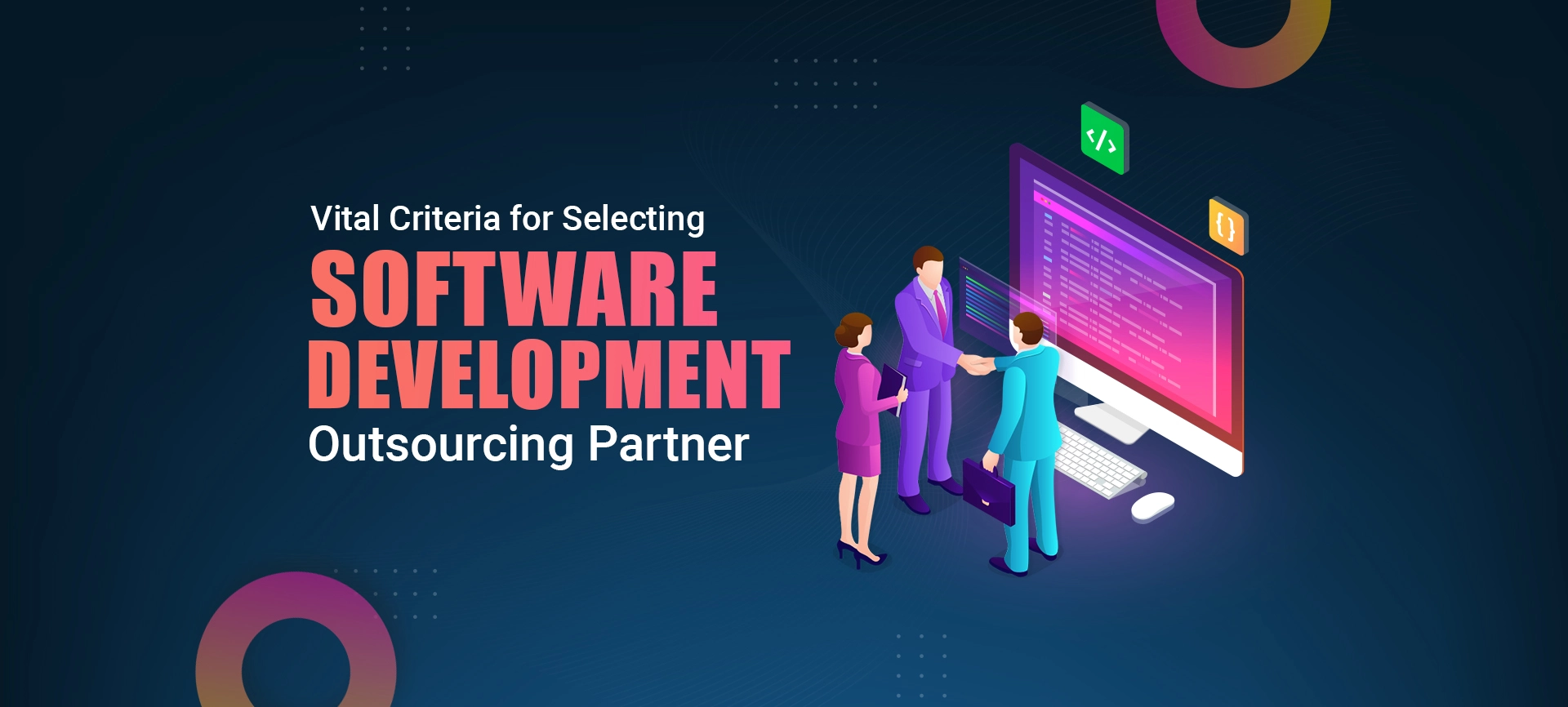
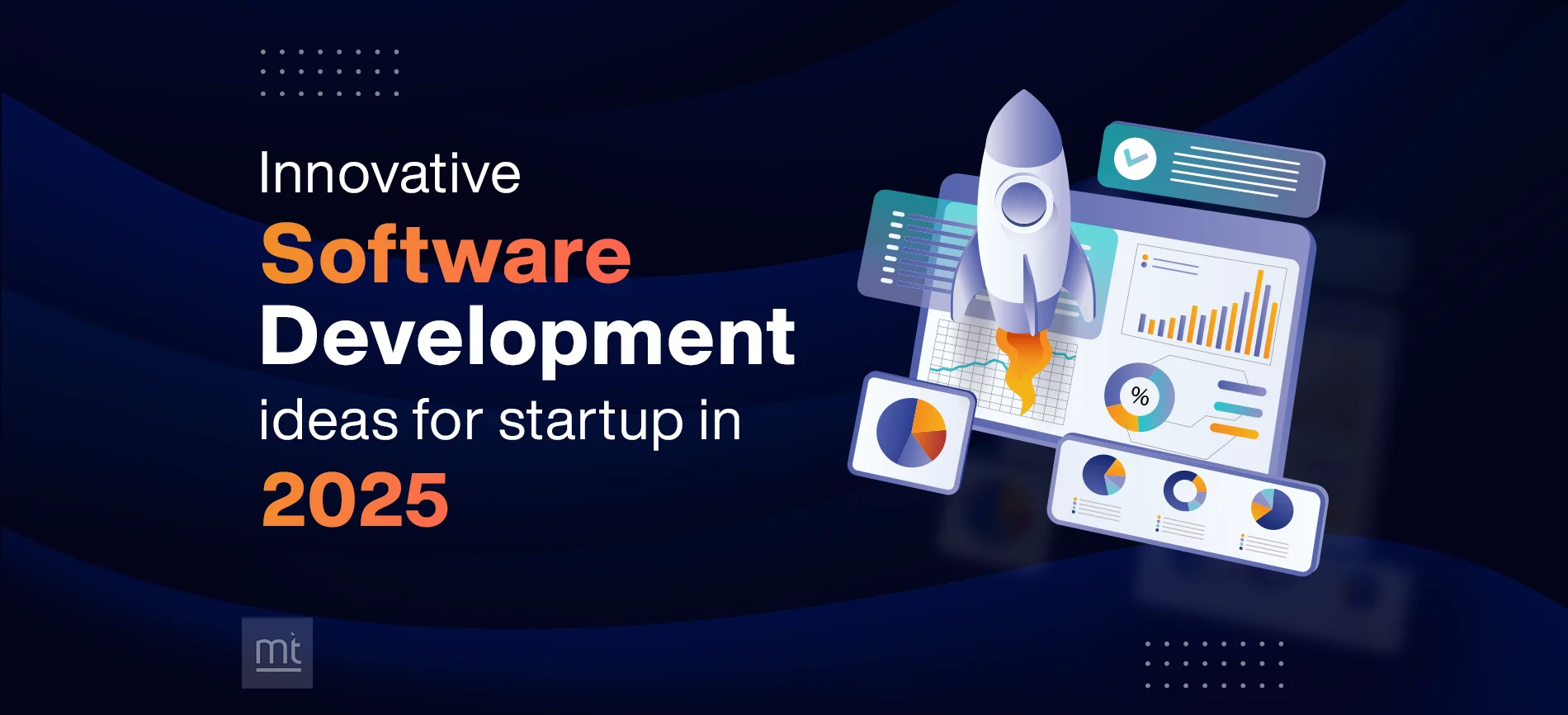
![Top 10 Software Development Companies in USA [Updated 2025]](https://www.manektech.com/storage/blog/image/1746450897.webp)



